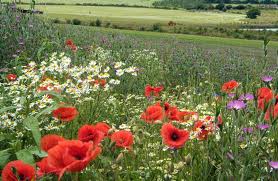





A grassy meadow can be full of life — lie down among the mixture of grasses and wild flowers and you can watch spiders building webs between blades of grass, caterpillars of the dingy skipper and common blue butterflies munching away on the leaves of bird’s foot trefoil, ants making tracks in the undergrowth and dancing bees collecting nectar from the white clover. Contrast this vibrant scene with the sterility of a closely mown, weed free lawn.
 Unfortunately, creating such a perfect wildflower meadow is not as easy as it sounds, because the average garden soil is high in nutrients and our native grasses grow extremely well, often defeating the attempts of other plants to survive. Yarrow, docks and plantains are among the few plants able to compete with grass. If the soil in your garden is deep and fertile, it may be necessary to remove some of the topsoil (keep it to add to flower beds and vegetable areas) and mix the remaining topsoil with the subsoil to reduce the fertility. If you have a thin and chalky or light and sandy topsoil, then there should be no problem because the grass will grow more slowly and so the wild flowers will be able to compete more successfully.
Unfortunately, creating such a perfect wildflower meadow is not as easy as it sounds, because the average garden soil is high in nutrients and our native grasses grow extremely well, often defeating the attempts of other plants to survive. Yarrow, docks and plantains are among the few plants able to compete with grass. If the soil in your garden is deep and fertile, it may be necessary to remove some of the topsoil (keep it to add to flower beds and vegetable areas) and mix the remaining topsoil with the subsoil to reduce the fertility. If you have a thin and chalky or light and sandy topsoil, then there should be no problem because the grass will grow more slowly and so the wild flowers will be able to compete more successfully.
In most gardens an area of mown grass is a necessity, as a space for relaxation, for children’s play or to form a calm, still centre to the brightly coloured surrounding beds and borders, but in many cases there may be space to have a lawn close to the house and then to have an area of grass meadow beyond. Mown grass paths around or through the meadow will allow access to the meadow and to other garden areas beyond .The site needs to be sunny but it does not need to be very large, just enough to allow room for a good variety of grasses and wild flowers. Suitable grasses are described in the directory, as are a range of wild flowers, the best of which are listed in the box opposite.
Your new meadow will need some care and attention. To start with, it will need mowing — first in spring before the wild flowers start growing and then again after the plants have flowered and set seed. All grass clippings need to be removed because they will smother new young plants and cause them to die. Never add fertilizer because this will only encourage the grass to grow more vigorously, which will stifle the wild flowers.
To add early spring interest to your wildflower meadow, plant some bulbs like snowdrops and wild daffodils. If you are starting with an existing lawn, these bulbs can be planted in autumn, either before or after adding the wild flowers, although snowdrops in particular are best planted in spring as plants ‘in the green’ rather than as bulbs. If sowing a meadow from seed, you need to allow the meadow at least a year to get established before adding the bulbs.
Copyright © www.100flowers.win Botanic Garden All Rights Reserved